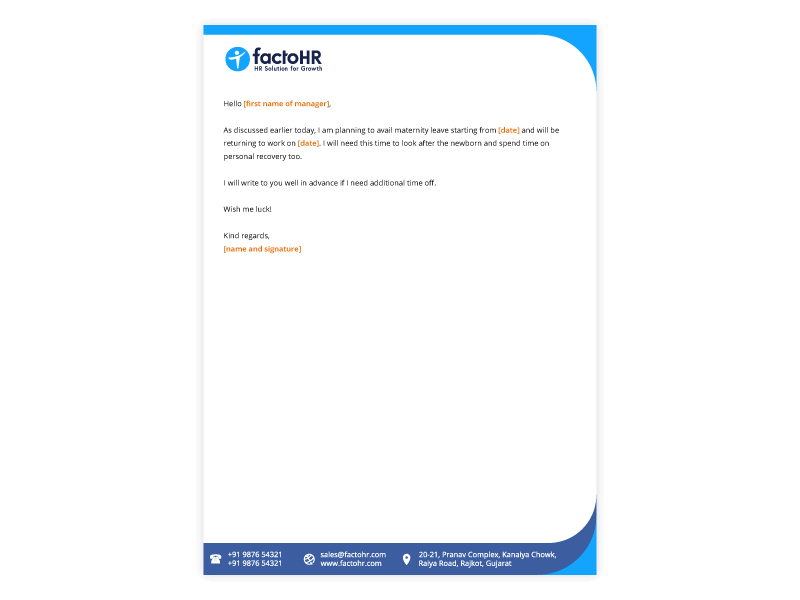Maternity Leave in India: Importance & Benefits

Table of Contents
Maternity leave is one of the many corrective measures that the progressive governments made to ensure there is parity between genders in the workplace. Traditionally, it so happened that women could not find time to bring a new life into the world if they had to compete with their male counterparts in career growth. They had to sacrifice either their career or the time they should spend with their newborn. Since the latter is non-negotiable for all practical purposes and for the baby’s well-being, they saw their careers take a beating. This situation can only change for women if the below two things happen:
- Women should be able to spend enough time with the newborn and when they return back to work, they should have a support system in place so that they can focus on their work while the baby is in someone’s care.
- Men need to help in child care and not leave that entirely to the mother alone. They should share the stress, difficulties as well as pleasures of rearing a child. That needed paternity leave (will be discussed in another blog).
Unfortunately, many companies still view this as a benefit extended to women employees. While it is so, it is also a benefit to the organisation and society at large. Women returning from maternity leave will be more productive as they know that their and their child’s well-being is taken care of. Support systems like a creche for the young ones will only help them to concentrate on the work better. Healthy children and productive women will benefit societies in the long run.

What is Maternity Leave?
It is the leave of absence provided to a woman who is either expecting to give birth or had a child born recently. This leave enables the mother to focus on child care without worrying about office work. The law governing this leave guarantees this right to women so that they are not subjected to discrimination because of their pregnancy and childbirth.
The first legislation that guaranteed 12 weeks of maternity leave in India was “The Maternity Benefit Act” of 1961. It is applicable to all establishments that employ ten or more. The only pre-condition was that the employee worked for a minimum of 80 days in the preceding 12 months to her expected delivery date.
This leave can be availed by eligible women either before the delivery or after childbirth. The employee is entitled to full pay for the duration of the eligible leave. There are different provisions for special cases:
- If there is a miscarriage, maternity leave is provided for 6 weeks.
- If the employee undergoes tubectomy, two weeks of leave is granted
- The duration of maternity leave is reduced to 6 weeks if the woman already has two or more living children.
This act also provides various other forms of support to women employees such as two nursing breaks in the year following delivery.
According to this act, employers are prohibited from terminating employees who are on maternity leave. Employers cannot quote pregnancy or maternity as the reason for termination. Violation of this rule ensures that the employer is penalised and the woman is compensated appropriately.
Maternity Benefit(Amendment) Act 2017
The amendment to the Maternity Benefit Act of 1961 further improved the existing act by increasing the duration of maternity leave and providing better benefits to working mothers. While the eligibility conditions have not changed, some of the important changes that came into force due to this amendment are
- Increase in maternity leave from twelve weeks to twenty-six.
- Increase in leave from six weeks to twelve in cases where the employee already has two or more children.
- An entitlement of additional twelve weeks of unpaid leave is made available as part of the amendment. To avail of this leave, the employee should inform the employer of her intention to utilise this additional leave in writing at least one month before the end of the maternity leave.
- This act mandates that every employer with more than fifty employees should provide creche facilities inside the office premises or within a prescribed distance from the workplace. Mothers can visit their wards in the creche four times during the day, which is considered part of the work hours.

Rules Governing Maternity Leave
The Maternity Benefit Act of 1961 and the subsequent amendment to the act in 2017 lay down the below rules:
Eligibility
The employee should have worked for a minimum of eighty days in the year preceding the date of expected delivery. The employer should have ten or more employees working in the organisation for this rule to apply.
Duration of maternity leave
The duration of leave for eligible employees is twenty-six weeks. Additional unpaid leave of twelve weeks can be availed with prior written information to the employer.
For women who already have 2 or more children
In cases where the employee already has two or more children, the entitlement to maternity leave is twelve weeks duration only.
In case of miscarriage
In the unfortunate case of a miscarriage of pregnancy, the woman employee is entitled to a maternity leave of six weeks.
For undergoing tubectomy operation
If a woman employee opts for a tubectomy operation, she is entitled to two weeks of maternity leave.
Nursing breaks
For a maximum of one year from the date of birth of the child, the woman employee is eligible for two nursing breaks a day.
Creche facilities
Every company that has 50 or more total employees should provide creche facilities. This facility should be within the prescribed distance from the workplace. The woman employee whose ward is in the creche can visit the facility four times a day. The time thus spent is counted as part of the working hours.
Prohibition of termination
Employers are prohibited from terminating the employment contract of a woman employee who is on maternity leave. They are also prohibited from dismissing or terminating women employees on the grounds of maternity or pregnancy.
Payment during maternity leave
The employee who availed of this leave is entitled to full pay of their salary. The employer should pay the same amount as they would if she worked the full duration of the leave period.
Most organisations ensure that their leave policy takes into consideration all these rules. They build on top of these rules and ensure they provide the best of the benefits to their employees to attract and retain top talent.

How to apply for maternity leave?
Most companies will have this as an option to select from their leave management system while applying for leave. However, as a good practice, it is always advised that the employee discusses with her direct manager about the impending need to go on maternity leave. This will help the manager and the rest of the team plan ahead to cover for the absence. If the company does not have a software system, it could just be a matter of writing a simple maternity letter addressing the manager and requesting leave, preferably after discussing first.

Conclusion
Governments and organisations should provide support systems to ensure women are not disadvantaged in the workplace because they have to bear children. Making sure that women do not have to worry about work when they are already stressed by pregnancy and childbirth, is what every good maternity leave policy should aim to achieve. By following the letter and spirit of the laws governing maternity leave, organisations can help create better societies where women can take an equal part in progress and development.
Grow your business with factoHR today
Focus on the significant decision-making tasks, transfer all your common repetitive HR tasks to factoHR and see the things falling into their place.

© 2025 Copyright factoHR


